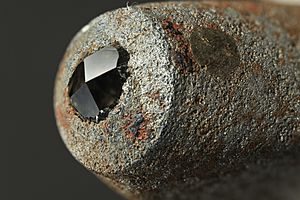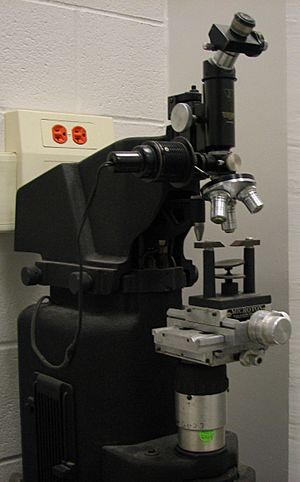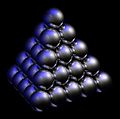Hardness facts for kids
Hardness is a measure of how hard a material is. Hard things resist pressure. Some examples of hard materials are diamond, carbides, quartz, tempered steel, ice, granite, concrete.
Harder materials are more difficult to cut and shape than softer ones. They are also usually more brittle which means they do not bend much but can shatter. Hard materials are important in industry. Cutting tools, machines and construction materials are usually hard.
The Mohs scale of mineral hardness is a scratch test of how hard minerals are. Compression tests and rebound tests are more used for metals and artificial materials.
Contents
Measuring hardness
There are three main types of hardness measurements: scratch, indentation, and rebound. Within each of these classes of measurement there are individual measurement scales. For practical reasons conversion tables are used to convert between one scale and another.
Scratch hardness
Scratch hardness is the measure of how resistant a sample is to fracture or permanent plastic deformation due to friction from a sharp object. The principle is that an object made of a harder material will scratch an object made of a softer material. When testing coatings, scratch hardness refers to the force necessary to cut through the film to the substrate. The most common test is Mohs scale, which is used in mineralogy. One tool to make this measurement is the sclerometer.
Another tool used to make these tests is the pocket hardness tester. This tool consists of a scale arm with graduated markings attached to a four-wheeled carriage. A scratch tool with a sharp rim is mounted at a predetermined angle to the testing surface. In order to use it a weight of known mass is added to the scale arm at one of the graduated markings, the tool is then drawn across the test surface. The use of the weight and markings allows a known pressure to be applied without the need for complicated machinery.
Indentation hardness
Indentation hardness measures the resistance of a sample to material deformation due to a constant compression load from a sharp object; they are primarily used in engineering and metallurgy fields. The tests work on the basic premise of measuring the critical dimensions of an indentation left by a specifically dimensioned and loaded indenter.
Common indentation hardness scales are Rockwell, Vickers, Shore, and Brinell.
Rebound hardness
Rebound hardness, also known as dynamic hardness, measures the height of the "bounce" of a diamond-tipped hammer dropped from a fixed height onto a material. This type of hardness is related to elasticity. The device used to take this measurement is known as a scleroscope.
Two scales that measures rebound hardness are the Leeb rebound hardness test and Bennett hardness scale.
Images for kids
See also
 In Spanish: Dureza para niños
In Spanish: Dureza para niños




